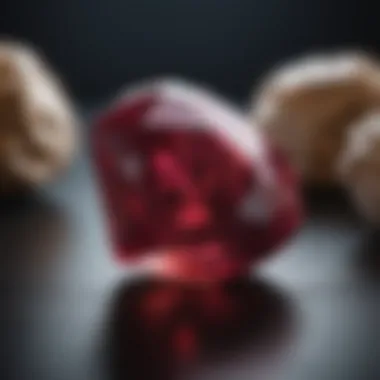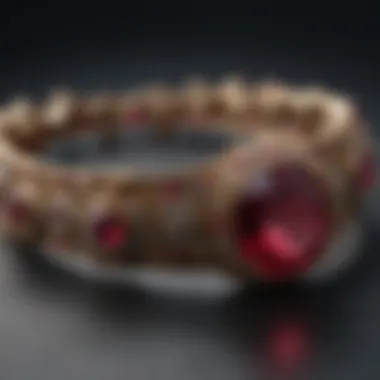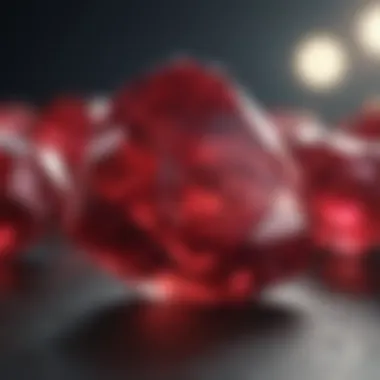Exploring the Intrinsic Value of Rubies


Intro
The ruby, a gemstone renowned for its rich red hue, has fascinated many throughout history. Its allure stems from a combination of beauty, rarity, and cultural significance. Many collectors and enthusiasts seek to understand the dynamics that drive the valuation of rubies in today’s market.
This exploration delves into the factors influencing ruby pricing from quality parameters to historical importance and market trends. The following sections illustrate the complexities of this gemstone industry and the insights required for informed collection and investment decisions.
Topic Overview
Definition of the Gemstone
Rubies are a variety of the mineral corundum, which is primarily composed of aluminum oxide. The deep red coloration of rubies comes from traces of chromium. As one of the four precious gemstones, alongside diamonds, emeralds, and sapphires, rubies stand out due to their vibrancy and durability.
Brief History and Significance
Historically, rubies have been regarded as symbols of power and passion. Ancient cultures believed that they possessed protective qualities, often worn by royalty. In addition, rubies have appeared in various literary works and artworks, solidifying their status as a coveted stone across ages. Today, they remain highly sought after by collectors and investors, further enhancing their value and appeal.
Identification and Classification
How to Categorize Rubies
The classification of rubies is primarily based on quality, which incorporates several criteria such as:
- Color: The most crucial attribute. Ideal rubies showcase a vivid red hue with minimal brown or orange undertones.
- Clarity: Fewer inclusions increase the stone’s value. Ideally, rubies should have minimal visible inclusions to the naked eye.
- Cut: The gemstone's skillful shaping impacts its brilliance and light transmission. A well-cut ruby will facilitate optimal sparkle.
- Carat weight: Larger stones are rarer and typically command higher prices, though color and clarity also play significant roles.
Tips for Identifying Key Features
When appraising a ruby, look for the following features:
- Examine the color carefully under natural light. The perfect red is often called "blood red."
- Check for inclusions with a jeweler's loupe. Surface blemishes can lower the value considerably.
- Observe the cut quality. The symmetry and finish should be assessed when determining desirability.
"Understanding the quality parameters is essential for any collector looking to invest in rubies. Rarity and beauty combined shape their exceptional value in the market."
By acknowledging these essential aspects of rubies, one can acquire a more profound understanding of their valuation. Proper appraisal not just aids in personal collection, but enhances one’s capability to make informed purchasing decisions, amid a market with intricate pricing dynamics.
Prelude to Rubies
Rubies, regarded as one of the most precious gemstones, hold a unique position in both historical narratives and modern valuation. This section provides a foundational understanding of what rubies represent within the broader context of gemstone appraisal and cultural relevance. Recognizing the significance of rubies is essential, as it allows collectors and enthusiasts to appreciate their rarity, beauty, and the intricate factors that contribute to their pricing dynamics. Engaging with the historical and cultural aspects sets the stage for deeper insights into the characteristics and market trends of rubies.
Historical Significance


The allure of rubies has transcended time, making them symbols of power and wealth across various civilizations. In ancient Thailand, rubies were believed to protect warriors in battle, while in Burma, they were considered sacred. The term itself is derived from the Latin word ruber, meaning red, a nod to the vibrant color that captures attention. The historical significance is evidenced by royal families adorning their crowns with these gemstones, showcasing their value.
Throughout history, rubies have been used as talisman and as offerings to deities, linking their physical beauty to spiritual significance. The prevalence of rubies in literature and art, from Shakespeare’s writings to royal portraits, highlights their enduring appeal. Understanding their historical journey adds depth to the appreciation of these gems and informs current market dynamics.
Cultural Importance
Culturally, rubies resonate deeply within various traditions. In many cultures, they symbolize love, passion, and desire. For instance, in Hinduism, rubies are associated with the sun and are regarded as protective stones, often worn by devotees. They are also celebrated in various folklore, each accentuating their desirability. The inclusion of rubies in wedding traditions, such as giving them as gifts, signifies their meaning as a stone of commitment.
Moreover, rubies play a role in modern jewelry trends. The contemporary appeal of rubies, often used in engagement rings and high-end pieces, reflects a blend of tradition and modernity. As consumers look for unique stones with rich histories, the cultural narrative surrounding rubies continues to enhance their significance in the market.
"Rubies have captured the human imagination for centuries, serving as symbols of love, power, and unyielding strength."
In summary, both the historical and cultural importance of rubies form a critical backdrop, setting a framework for understanding the complex landscape of their pricing, availability, and value in contemporary markets.
Understanding Ruby Characteristics
The section on Understanding Ruby Characteristics provides essential insights into what makes rubies a sought-after gemstone. Recognizing the unique traits of rubies can greatly enhance appreciation and guide informed purchasing decisions. Each characteristic plays a role in determining the value and allure of a ruby. Collectors and enthusiasts can gain a deeper understanding of rubies by exploring these traits.
Color and Hue Variations
The color of a ruby is one of its most defining features. Rubies are primarily known for their vivid red hue, which is a result of chromium content. However, rubies do come in various colors, including pinkish-red and purplish-red. The most prized rubies are those that display a deep, rich red color known as "pigeon's blood." This term refers to the intense red shade and is often associated with the highest quality stones.
When assessing color, it is important to consider tone and saturation. A ruby with a bright and intense color can command a higher price than one that appears dull. Collectors should also be aware that lighting conditions can affect how the color is perceived. For instance, natural daylight tends to showcase a ruby's true hue better than artificial light.
Clarity and Transparency
Clarity refers to the presence of inclusions or internal flaws within a ruby. A clear ruby with minimal inclusions is generally more valuable. However, unlike diamonds, some inclusions in rubies can be acceptable and even add character to the stone. For example, silk inclusions might create a star effect in certain gemstones, increasing their appeal.
Transparency is also a critical factor. Rubies should ideally be transparent, allowing light to pass through and enhance their color and brilliance. In buying rubies, clarity and transparency are crucial indicators of quality and should be carefully evaluated in a well-lit environment.
Cut and Shape
The cut of a ruby determines its overall appearance and is essential to its market value. A well-cut ruby reflects light beautifully and enhances its aesthetic appeal. Common shapes for rubies include oval, round, square, and pear. Each shape can highlight different characteristics of the stone.
Moreover, the cut should maintain the weight of the stone as much as possible. A poorly cut ruby may appear less vibrant, even if it possesses excellent color and clarity. Enthusiasts should study how the cut contributes to a stone's brilliance and factor this into their purchasing decisions.
Carat Weight Impact
Carat weight significantly impacts the value of a ruby. Generally, larger rubies are rarer and more expensive. However, the quality of the stone also plays a crucial role. For instance, a smaller ruby with superior color and clarity may have a price point comparable to or even higher than a larger but less appealing stone.


The relationship between carat weight and price is not linear. Prices can increase exponentially with carat weight, especially when going from smaller to larger sizes. Collectors should analyze how weight affects the price and weigh their options carefully based on each ruby's unique characteristics.
Factors Influencing Ruby Prices
Understanding the pricing of rubies is quite important inappreciating their value and investment potential. The market is dynamic and influenced by many factors. By examining these influences, collectors can make better decisions. Each element carefully interacts to affect how prices are set and fluctuated.
Market Demand
The demand for rubies plays a vital role in determining their price. When consumer interest rises, prices tend to follow. High-profile sales at auctions have often showcased the value of unique rubies, creating a ripple effect on the market. Notable pieces gain attention, and collectors are willing to pay a premium to obtain rubies of exceptional quality.
Additionally, trends in fashion and jewelry also impact ruby demand. For example, designers integrating rubies into modern designs attract consumers who value both tradition and contemporary aesthetics. Furthermore, cultural events or movements can spur interest, resulting in price surges. It’s of utmost importance for enthusiasts to pay attention to shifts in consumer behavior.
Supply Chain Dynamics
Supply chain dynamics influence ruby prices significantly. A crucial factor is the source of the rubies. For instance, rubies from Myanmar, known for their rich color, generally command higher prices due to their quality and rarity. Conversely, rubies from countries with less reputation face more price competition.
Moreover, the process of extraction and distribution adds another layer to the pricing. Issues like political instability affecting supply routes can cause scarcity, thereby increasing prices. On the other hand, efficient and stable supply chains can help maintain consistent pricing. Therefore, understanding where rubies come from and the challenges in their supply is necessary for anyone interested in the ruby market.
Economic Influences
Overall economic conditions can sway ruby pricing. In times of economic prosperity, luxury items like rubies see increased sales, driving up prices. Collectors often invest more when they feel secure in their financial situations. Conversely, economic downturns can lead to decreased demand and lower prices.
Foreign exchange rates also influence prices. Rubies traded in U.S. dollars may see fluctuations depending on the strength of the dollar relative to other currencies. These economic factors make understanding the broader financial environment essential for collectors and investors alike.
"The price of rubies is sensitive to the interplay of demand, supply, and economic conditions, making it a complex yet fascinating market to navigate."
Overall, those who are serious about collecting rubies should keep a vigilant view on these market influences. In doing so, they can better navigate the intricacies of pricing dynamics, ensuring they make informed decisions.
Market Trends for Rubies
Understanding the market trends for rubies is essential for collectors and investors. This section examines factors that influence the current pricing landscape. The ruby market has shown resilience despite economic fluctuations. Buyers and investors should note how consumer preferences and global changes can shape pricing and demand.
Regional Price Variations
Regional price variations significantly impact the overall valuation of rubies. Prices can differ based on where the rubies are sourced, sold, or collected. For instance, rubies from Myanmar or Burma have a reputation for their color and quality, which often leads to higher market prices. On the other hand, rubies from Africa or Sri Lanka may offer a more accessible entry point for budget-conscious buyers yet still maintain their unique appeal.
Several factors contribute to these regional disparities:
- Geological Factors: The location where a ruby is mined influences its quality and hence its price. Mines rich in mineral deposits often produce superior stones.
- Cultural Influence: Some regions may have a deeper cultural appreciation for rubies, driving demand and pricing higher.
- Supply and Demand Dynamics: Local market economics affect ruby prices. Regions with higher demand and limited supply will see inflated prices.


This variation aids buyers in understanding appropriate market values and encourages informed purchasing decisions.
Emerging Markets
Emerging markets present new opportunities for ruby consumers and investors. Countries like India and China are increasingly becoming major players in the ruby market. With rising disposable incomes and a growing appreciation for luxury goods, these nations demand more high-quality rubies, thus reshaping global pricing structures.
- Investment Growth: As more collectors in these regions enter the market, the demand for rubies is likely to increase. This trend can lead to price escalations for high-quality stones that appeal to new buyers.
- Cultural Shifts: In countries such as India, traditional gemstones like rubies are often preferred over others in jewelry, fostering an ongoing market for high-quality pieces. This cultural preference shifts how rubies are valued.
- Accessible Technology: The internet provides easier access for buyers from these emerging markets to connect with suppliers globally. This can result in a more competitive market and pressures on pricing.
Overall, emerging markets are reshaping the ruby landscape. Collectors need to stay attuned to these economic shifts. Understanding how these dynamics influence pricing can empower buyers during acquisitions.
Evaluating Ruby Quality
Evaluating the quality of rubies is essential for understanding their value in the market. This section will explore various aspects that contribute to the assessment of ruby quality. A well-evaluated ruby not only enhances the purchase experience but also aids in investment choices. Identification of quality factors is crucial for collectors and enthusiasts who want to make informed decisions.
Certification Processes
Certification processes play a pivotal role in the ruby market. When a ruby is assessed and certified by a reputable gemological organization, it gains authenticity and trustworthiness. This certification typically includes detailed information about the stone's characteristics, such as color, clarity, cut, and carat weight.
- GIA (Gemological Institute of America): One of the most recognized certifiers, GIA offers unbiased evaluations focusing on the four Cs of gemstones.
- AGL (American Gemological Laboratories): AGL provides comprehensive reports, especially for Burmese rubies, which are already prized in the market.
- IGI (International Gemological Institute): Known for its global outreach, IGI evaluates rubies and other gemstones, ensuring quality standards.
When buying a ruby, always look for a certification that guarantees its quality. Without this, you could be misled about the gemstone's real value.
Appraisal Methods
Appraisal methods are another important aspect when it comes to evaluating ruby quality. Professionals often rely on systematic approaches to ensure that a ruby's value is accurately determined. There are various techniques used in appraisal:
- Visual inspection: This includes examining the gemstone under magnification to assess its features.
- Instrumentation: Items like refractometers and spectrometers assist in determining a ruby’s physical properties, such as refractive index and absorption spectrum.
- Comparative analysis: Appraisers often compare the ruby against similar stones in order to evaluate market trends and price points.
"Understanding appraisal methods can directly impact investment returns and personal satisfaction in the ruby buying process."
Utilizing certified evaluations and employing reliable appraisal techniques are key to a collector's success in the ruby market. Ensuring these methods during the purchase can lead to not just immediate satisfaction, but also substantial long-term value.
The End
The conclusion serves as a critical synthesis of the information explored throughout this article. Understanding the value of rubies is not merely an exercise in appreciation. It has practical implications for collectors, investors, and enthusiasts alike. The analysis of historical significance, market dynamics, and quality evaluation equips individuals with valuable insights. This knowledge can enhance decision-making when purchasing or investing in ruby gemstones.
Future Outlook
Looking to the future, the ruby market shows signs of evolving trends. Several factors might influence this evolution, including:
- Technological Advancements: Enhanced gemological technologies will improve quality assessment. Buyers will benefit from precise evaluations of rubies.
- Market Internationalization: A rise in global appreciation for gemstones may lead to increased demand. Emerging markets could offer new opportunities.
- Sustainability Concerns: Ethical sourcing and environmental awareness may shape buyer preferences.
These aspects will affect both pricing and availability. Consequently, staying informed about these developments is essential for seasoned collectors. Collectors should regularly consult industry reports and market analyses.
"As the ruby market changes, collectors must adapt their strategies accordingly, ensuring they remain ahead in a competitive environment."
In summary, the exploration of ruby value is multifaceted. It encompasses historical, cultural, and economic dimensions. A comprehensive understanding enables informed choices in an intricate marketplace.



